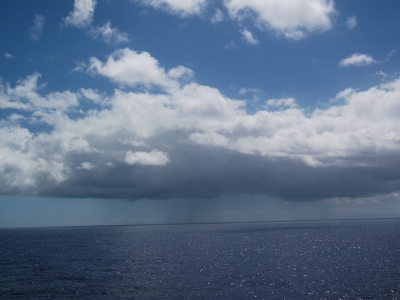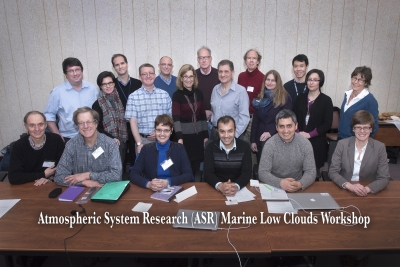ASR Marine Low Clouds Workshop Held
Published: 29 February 2016

While they may not elicit the excitement and drama of their deeper, more-intense, sibling thunderstorm clouds that are associated with severe weather and catastrophic damage, low clouds over oceans are important players in the Earth’s climate story. Marine low clouds represent one of the largest uncertainties and most important feedback factors in current-generation climate models.
These clouds are generally confined to the lowest couple of kilometers above the ocean surface and produce nothing stronger than a drizzle. However, they reflect much of the incoming solar radiation, but they have very little impact on the longwave radiation, which results in a strong net cooling of the surface and atmospheric column.
Despite this important role in the Earth’s energy balance, these clouds are poorly represented in climate models and represent one of the greatest uncertainties in simulations of future climate states. This difficulty primarily is related to gaps in our understanding of small-scale processes that determine the life cycle of these clouds and the representation of these processes in the models.

To better define current gaps in our understanding and measurements of marine low cloud properties and processes and identify strategies on how to address them, the U.S. Department of Energy (DOE) Atmospheric System Research (ASR) Program sponsored the Marine Low Clouds Workshop at Brookhaven National Laboratory from January 27 to 29, 2016.
The ASR Program works with the DOE-funded Atmospheric Radiation Measurement (ARM) Climate Research Facility, using ARM data sets gathered over a range of environmental conditions at several fixed and mobile sites situated in climatically diverse locations, including the Eastern North Atlantic site, a region characterized by marine stratocumulus clouds. ASR principal investigators are an important user group for the ARM Facility, contributing 75 percent of scientific publications resulting from ARM data.
This workshop brought together 17 leading researchers from the fields of marine aerosols, clouds, observations, and modeling.
Presentations and discussions focused on five major themes:
- cloud-aerosol-precipitation interactions and the cloud condensation nuclei budget in the marine boundary layer
- mesoscale organization of clouds
- entrainment and mixing
- precipitation
- modeling needs.
Workshop participants identified current research gaps, developed strategies to address these gaps, and identified needs for new collaborations, measurements, and modeling activities.
Some of the specific science questions considered were:
- How much and how frequently do marine low clouds precipitate, and how can we measure this precipitation accurately?
- What controls entrainment in marine low clouds, and what impacts does it have on boundary layer and cloud structure and aerosols?
- What controls the mesoscale organization of marine low clouds and what impacts does this have on boundary layer and cloud structure and aerosols?
- Do high cloud condensation nuclei concentrations lead to increased cloud droplet concentrations and suppressed precipitation?
A summary of the discussions and outcomes of the workshop is currently being prepared and will be published as an ASR report when completed.
The ARM Climate Research Facility is a DOE Office of Science user facility. The ARM Facility is operated by nine DOE national laboratories, including .
Keep up with the Atmospheric Observer
Updates on ARM news, events, and opportunities delivered to your inbox
ARM User Profile
ARM welcomes users from all institutions and nations. A free ARM user account is needed to access ARM data.


















